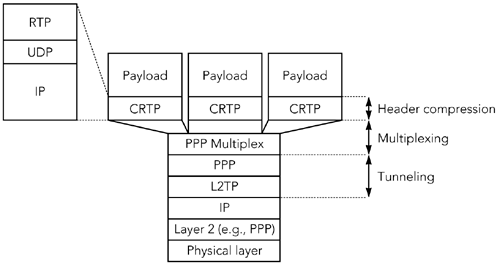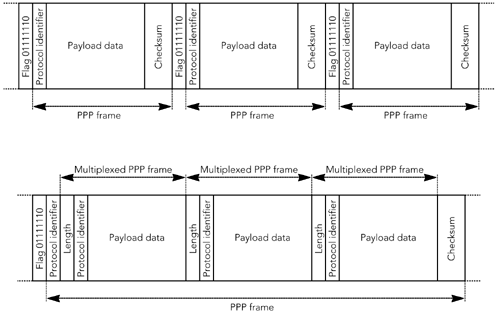Tunneling Multiplexed Compressed RTP
| The IETF Audio/Video Transport working group received numerous proposals for RTP multiplexing solutions. Many of these were driven by the needs of specific applications, and although they may have solved the needs of those applications, they generally failed to provide a complete solution. One of the few proposals to keep the semantics of RTP was Tunneling Multiplexed Compressed RTP (TCRTP), which was adopted as the recommended "best current practice" solution. 52 Basic Concepts of TCRTPThe TCRTP specification describes how existing protocols can be combined to provide a multiplex . It does not define any new mechanisms. The combination of RTP header compression, the Layer Two Tunneling Procotol (L2TP), 31 and PPP multiplexing 39 provides the TCRTP system, with the protocol stack shown in Figure 12.2. Header compression is used to reduce the header overhead of a single RTP payload. Tunneling is used to transport compressed headers and payloads through a multiple-hop IP network without having to compress and decompress at each link. Multiplexing is used to reduce the overhead of tunnel headers by amortizing a single tunnel header over many RTP payloads. Figure 12.2. TCRTP Protocol Stack The first stage of TCRTP is to compress the header, which it does in the usual way, negotiating the use of either CRTP or ROHC over a PPP link. The difference is that the PPP link is a virtual interface representing a tunnel rather than a real link. The tunnel is essentially invisible to the header compression, making its presence known only because of the loss and delay characteristics imposed. The concept is much as if the RTP implementation were running over a virtual private network (VPN) link, except that the aim is to provide more efficient transport, rather than more secure transport. Compared to a single physical link, a tunnel typically has a longer round-trip time, may have a higher packet loss rate, and may reorder packets. As discussed in Chapter 11, Header Compression, links with these properties have adverse effects on CRTP header compression and may lead to poor performance. There are enhancements to CRTP under development that will reduce this problem. 43 ROHC is not a good fit because it requires in-order delivery, which cannot be guaranteed with a tunnel. The tunnel is created by means of L2TP providing a general encapsulation for PPP sessions over an IP network. 31 This is a natural fit because both CRTP and ROHC are commonly mapped onto PPP connections, and L2TP allows any type of PPP session to be negotiated transparently . If the interface to the PPP layer is correctly implemented, the CRTP/ROHC implementation will be unaware that the PPP link is a virtual tunnel. Unfortunately, when the overhead of a tunnel header is added to a single compressed RTP payload, there is very little bandwidth savings compared to uncompressed transport of RTP streams. Multiplexing is required to amortize the overhead of the tunnel header over many RTP payloads. The TCRTP specification proposes the use of PPP multiplexing 39 for this purpose. PPP multiplexing combines consecutive PPP frames into a single frame for transport. It is negotiated as an option during PPP connection setup, and it supports multiplexing of variable sizes and types of PPP frames , as shown in Figure 12.3. Figure 12.3. PPP Multiplexing PPP adds framing to a point-to-point bit stream so that it can transport a sequence of upper-layer packets. At least four octets of framing are added to each upper-layer packet: a flag octet to signify the start of the PPP frame, followed by a protocol identifier, the mapped upper packet as payload data, and a two-octet check-sum (other framing headers may be present, depending on the options negotiated during channel setup). With several frames multiplexed into one, the PPP overhead is reduced from four octets per packet to two. The need for TCRTP to include multiplexing becomes clear when the overhead of tunneling is considered . When PPP frames are tunneled over IP via L2TP, there is an overhead of 36 octets per frame (L2TP header compression 46 may reduce this number to 20 octets per frame). This amount of overhead negates the gain from header compression, unless frames are multiplexed before they are tunneled. Implementing TCRTPTCRTP has the advantage of being invisible to the upper-layer protocols. An application generating RTP packets cannot tell whether those packets are multiplexed, and it should be possible to add a multiplex to an existing application without changing that application. The versatility of multiplexing allows great flexibility in the use of TCRTP. For example, TCRTP may be implemented as a virtual network interface on a host to multiplex locally generated packets, or on a router to multiplex packets that happen to flow between two common intermediate points, or as part of a standalone gateway from PSTN (Public Switched Telephone Network) to IP, multiplexing voice calls in a telephony system. Depending on the scenario, TCRTP may be implemented in many ways. One possible implementation is for the TCRTP stack to present itself to the rest of the system as a standard PPP network interface, which allows the negotiation of RTP header compression. Internally, it will implement PPP multiplexing and L2TP tunneling, but this implementation is transparent to the applications. The transparency of the TCRTP interface depends primarily on the operating system. If the IP protocol implementation is only loosely coupled to the layer-two interface, it should be possible to add a new interface ”TCRTP ”relatively easily and transparently. If the IP layer is tightly coupled to the layer-two interface, as may occur in an embedded system in which the TCP/IP implementation is tuned to the characteristics of a particular link, then the process may be more difficult. A more serious problem may be the interaction between layer-two interfaces and other parts of the network stack. TCRTP is a tunneling protocol, in which compressed RTP/UDP/IP is layered above multiplexed PPP and L2TP, and then layered above UDP/IP. If the operating system does not support the concept of tunnel interfaces, this layering of IP-over-something-over-IP can be problematic and require extensive work. It is also helpful if the system hides tunnel interfaces within the abstraction of a normal network interface because otherwise the different API for tunnel interfaces raises the possibility of application incompatibility with TCRTP. Within a TCRTP interface, the degree of multiplexing must be carefully controlled to bound the delay, while ensuring that sufficient packets are included in the multiplex to keep the header overhead within acceptable limits. If too few packets are multiplexed together, the per-packet headers become large and negate the effects of the multiplex. We can avoid this problem by delaying sending multiplexed packets until they have accumulated sufficient data to make the header overhead acceptable; however, because interactive applications need a total end-to-end delay of less than approximately 150 milliseconds , the multiplex cannot afford to insert much delay. Non-RTP traffic can be sent through a TCRTP tunnel but will cause a significant reduction in compression efficiency, so it is desirable to separate it from the RTP traffic. The destination address can be used to separate the two types of traffic if the implementations cooperate to ensure that only RTP packets are sent to a particular destination, or a more extensive examination of the packet headers can be used (for example, checking that the packets are UDP packets destined for a particular port range). Because RTP does not use a fixed port, there is no direct way of distinguishing an RTP flow from a non-RTP flow; so the multiplex cannot be certain that only RTP packets are transported, unless the applications generating those packets cooperate with the multiplex in some manner. PerformanceThe bandwidth saved by the use of TCRTP depends on several factors, including the multiplexing gain, the expected packet loss rate within the tunnel, and the rate of change of fields within the multiplexed RTP and IP headers. Multiplexing reduces the overhead due to the PPP and L2TP headers, and the reduction is greater as an increasing number of streams are multiplexed together into each PPP frame. Performance always increases as more flows are multiplexed together, although the incremental gain per flow is less as the total number of flows in the multiplex increases . The packet loss rate, and the rate of change of the header fields, can have an adverse effect on the header compression efficiency. Packet loss will cause context invalidation , which will cause compression to switch to a less efficient mode of operation while the context is refreshed. The problem is particularly acute if standard CRTP is used; enhanced CRTP performs much better. Changes in the header fields may also cause the compression to transition to a less efficient mode of operation, sending first-order deltas instead of fully compressed second-order deltas. Little can be done about this, except to note that the section titled Considerations for RTP Applications, in Chapter 11, Header Compression, is also relevant to TCRTP. The TCRTP specification includes a simple performance model, which attempts to predict the bandwidth used by a voice-over-IP stream (given enhanced CRTP compression), the packet size and duration, the average talk spurt length, the number of packets that can be multiplexed, and estimates of the overhead due to changes in the compressed RTP and IP headers. This model predicts that TCRTP will achieve a rate of 14.4 Kbps for a G.729 stream with 20-millisecond packets, three packets multiplexed into one, and an average talk spurt length of 1,500 milliseconds. This compares well with the 12 Kbps achieved by hop-by-hop CRTP, and the 25.4 Kbps of standard RTP with no header compression or multiplexing (all numbers include the layer-two overhead due to PPP-in-HDLC [High-level Data Link Control] framing). Performance will, of course, depend heavily on the characteristics of the media and network, but it is believed that the relative performance seen in the example is not unrealistic . Provided that there is sufficient traffic to multiplex, TCRTP will perform significantly better than standard RTP but slightly worse than hop-by-hop header compression. |
EAN: 2147483647
Pages: 108
- Chapter I e-Search: A Conceptual Framework of Online Consumer Behavior
- Chapter II Information Search on the Internet: A Causal Model
- Chapter III Two Models of Online Patronage: Why Do Consumers Shop on the Internet?
- Chapter IX Extrinsic Plus Intrinsic Human Factors Influencing the Web Usage
- Chapter X Converting Browsers to Buyers: Key Considerations in Designing Business-to-Consumer Web Sites

